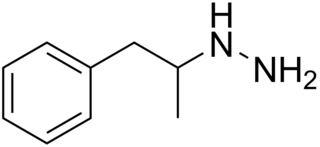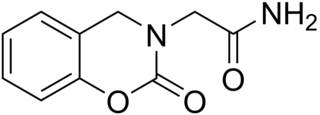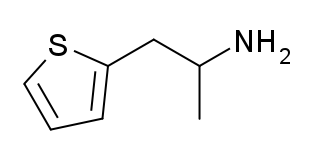
Monoamine oxidase inhibitors (MAOIs) are a class of drugs that inhibit the activity of one or both monoamine oxidase enzymes: monoamine oxidase A (MAO-A) and monoamine oxidase B (MAO-B). They are best known as effective antidepressants, especially for treatment-resistant depression and atypical depression. They are also used to treat panic disorder, social anxiety disorder, Parkinson's disease, and several other disorders.

Monoamine oxidases (MAO) are a family of enzymes that catalyze the oxidation of monoamines, employing oxygen to clip off their amine group. They are found bound to the outer membrane of mitochondria in most cell types of the body. The first such enzyme was discovered in 1928 by Mary Bernheim in the liver and was named tyramine oxidase. The MAOs belong to the protein family of flavin-containing amine oxidoreductases.

Tranylcypromine, sold under the brand name Parnate among others, is a monoamine oxidase inhibitor (MAOI). More specifically, tranylcypromine acts as nonselective and irreversible inhibitor of the enzyme monoamine oxidase (MAO). It is used as an antidepressant and anxiolytic agent in the clinical treatment of mood and anxiety disorders, respectively.

Several alkaloids that function as monoamine oxidase inhibitors (MAOIs) are found in the seeds of Peganum harmala, as well as tobacco leaves including harmine, harmaline, and harmalol, which are members of a group of substances with a similar chemical structure collectively known as harmala alkaloids. These alkaloids are of interest for their use in Amazonian shamanism, where they are derived from other plants. The harmala alkaloid harmine, once known as telepathine and banisterine, is a naturally occurring beta-carboline alkaloid that is structurally related to harmaline, and also found in the vine Banisteriopsis caapi. Tetrahydroharmine is also found in B. caapi and P. harmala. Dr. Alexander Shulgin has suggested that harmine may be a breakdown product of harmaline. Harmine and harmaline are both a reversible inhibitor of monoamine oxidase A (RIMAs). They can stimulate the central nervous system by inhibiting the metabolism of monoamine compounds such as serotonin and norepinephrine.

Isocarboxazid is a non-selective, irreversible monoamine oxidase inhibitor (MAOI) of the hydrazine class used as an antidepressant. Along with phenelzine and tranylcypromine, it is one of only three classical MAOIs still available for clinical use in the treatment of psychiatric disorders in the United States, though it is not as commonly employed in comparison to the others.

Clorgiline (INN), or clorgyline (BAN), is a monoamine oxidase inhibitor (MAOI) structurally related to pargyline which is described as an antidepressant. Specifically, it is an irreversible and selective inhibitor of monoamine oxidase A (MAO-A). Clorgiline was never marketed, but it has found use in scientific research. It has been found to bind with high affinity to the σ1 receptor (Ki = 3.2 nM) and with very high affinity to the I2 imidazoline receptor (Ki = 40 pM).

Monoamine oxidase B, also known as MAOB, is an enzyme that in humans is encoded by the MAOB gene.

Minaprine is a monoamine oxidase inhibitor antidepressant drug that was used in France for the treatment of depression until it was withdrawn from the market in 1996 because it caused convulsions.
Pirlindole is mainly a reversible inhibitor of monoamine oxidase A (RIMA) and secondly a SNRI which was developed and is used in Russia as an antidepressant. It is structurally and pharmacologically related to metralindole.

Bifemelane (INN), or bifemelane hydrochloride (JAN), also known as 4-(O-benzylphenoxy)-N-methylbutylamine, is an antidepressant and cerebral activator that is widely used in the treatment of cerebral infarction patients with depressive symptoms in Japan, and in the treatment of senile dementia as well. It also appears to be useful in the treatment of glaucoma. Bifemelane acts as a monoamine oxidase inhibitor (MAOI) of both isoenzymes, with competitive (reversible) inhibition of MAO-A and non-competitive (irreversible) inhibition of MAO-B, and also acts (weakly) as a norepinephrine reuptake inhibitor. The drug has nootropic, neuroprotective, and antidepressant-like effects in animal models, and appears to enhance the cholinergic system in the brain.

Pheniprazine is an irreversible and nonselective monoamine oxidase inhibitor (MAOI) of the hydrazine chemical class that was used as an antidepressant in the 1960s. It was also used in the treatment of angina pectoris and schizophrenia. Pheniprazine has been largely discontinued due to toxicity concerns such as jaundice, amblyopia, and optic neuritis.

Ladostigil (TV-3,326) is a novel neuroprotective agent being investigated for the treatment of neurodegenerative disorders like Alzheimer's disease, Lewy body disease, and Parkinson's disease. It acts as a reversible acetylcholinesterase and butyrylcholinesterase inhibitor, and an irreversible monoamine oxidase B inhibitor, and combines the mechanisms of action of older drugs like rivastigmine and rasagiline into a single molecule. In addition to its neuroprotective properties, ladostigil enhances the expression of neurotrophic factors like GDNF and BDNF, and may be capable of reversing some of the damage seen in neurodegenerative diseases via the induction of neurogenesis. Ladostigil also has antidepressant effects, and may be useful for treating comorbid depression and anxiety often seen in such diseases as well.
Metralindole (Inkazan) is a reversible inhibitor of monoamine oxidase A (RIMA) which was investigated in Russia as a potential antidepressant. It is structurally and pharmacologically related to pirlindole.

Amiflamine (FLA-336) is a reversible inhibitor of monoamine oxidase A (MAO-A), thereby being a RIMA, and, to a lesser extent, semicarbazide-sensitive amine oxidase (SSAO), as well as a serotonin releasing agent (SRA). It is a derivative of the phenethylamine and amphetamine chemical classes. The (+)-enantiomer is the active stereoisomer.

Caroxazone is an antidepressant which was formerly used for the treatment of depression but is now no longer marketed. It acts as a reversible monoamine oxidase inhibitor (RIMA) of both MAO-A and MAO-B subtypes, with five-fold preference for the latter.

Almoxatone (MD-780,236) is a selective and reversible inhibitor of MAO-B. It was patented as an antidepressant and antiparkinsonian agent but was never marketed.

Thiopropamine is a stimulant drug which is an analogue of amphetamine where the phenyl ring has been replaced by thiophene. It has similar stimulant effects to amphetamine but with around one third the potency. The N-methyl and thiophen-3-yl analogues are also known and are somewhat more potent, though still generally weaker than the corresponding amphetamines.

Bazinaprine (SR-95,191) is an experimental drug candidate. It is a monoamine oxidase inhibitor (MAOI) which is believed to be useful for the treatment of depression. The drug strongly inhibits type A monoamine oxidase, but only weakly inhibits type B. The effects of the drug are reversible in vivo, but not in vitro. In studies, the chemical has been shown to not interact in vivo with other neurotransmitter or drug receptor sites.

Mofegiline (MDL-72,974) is a selective, irreversible inhibitor of monoamine oxidase B (MAO-B) and semicarbazide-sensitive amine oxidase (SSAO) which was under investigation for the treatment of Parkinson's disease and Alzheimer's disease, but was never marketed.

Acetryptine (INN), also known as 5-acetyltryptamine (5-AT), is a drug described as an antihypertensive agent which was never marketed. Structurally, acetryptine is a substituted tryptamine, and is closely related to other substituted tryptamines like serotonin (5-hydroxytryptamine). It was developed in the early 1960s. The binding of acetryptine to serotonin receptors does not seem to have been well-investigated, although it was assessed at the 5-HT1A and 5-HT1D receptors and found to bind to them with high affinity. The drug may also act as a monoamine oxidase inhibitor (MAOI); specifically, as an inhibitor of MAO-A.


















